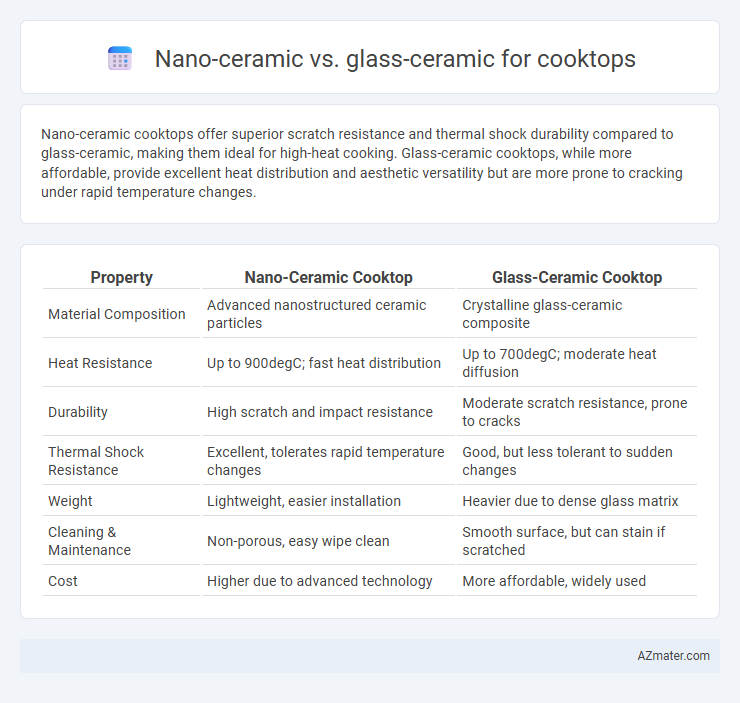Nano-ceramic cooktops offer superior scratch resistance and thermal shock durability compared to glass-ceramic, making them ideal for high-heat cooking. Glass-ceramic cooktops, while more affordable, provide excellent heat distribution and aesthetic versatility but are more prone to cracking under rapid temperature changes.
Table of Comparison
| Property | Nano-Ceramic Cooktop | Glass-Ceramic Cooktop |
|---|---|---|
| Material Composition | Advanced nanostructured ceramic particles | Crystalline glass-ceramic composite |
| Heat Resistance | Up to 900degC; fast heat distribution | Up to 700degC; moderate heat diffusion |
| Durability | High scratch and impact resistance | Moderate scratch resistance, prone to cracks |
| Thermal Shock Resistance | Excellent, tolerates rapid temperature changes | Good, but less tolerant to sudden changes |
| Weight | Lightweight, easier installation | Heavier due to dense glass matrix |
| Cleaning & Maintenance | Non-porous, easy wipe clean | Smooth surface, but can stain if scratched |
| Cost | Higher due to advanced technology | More affordable, widely used |
Introduction to Cooktop Surface Materials
Nano-ceramic cooktop surfaces offer enhanced scratch resistance and improved heat distribution compared to traditional glass-ceramic materials, making them highly durable for everyday cooking. Glass-ceramic surfaces remain popular due to their smooth finish, ease of cleaning, and good thermal shock resistance, balancing performance and cost-effectiveness. Both materials utilize advanced thermal properties, but nano-ceramics integrate nanotechnology to optimize energy efficiency and longevity in kitchen appliances.
What is Nano-Ceramic Technology?
Nano-ceramic technology in cooktops utilizes nanometer-sized ceramic particles to enhance heat distribution and surface durability, offering superior thermal performance compared to traditional glass-ceramic surfaces. These nano-ceramics provide increased scratch resistance, higher heat tolerance, and improved energy efficiency, resulting in faster cooking times and extended cooktop lifespan. The advanced molecular structure of nano-ceramics allows for better heat conduction and easier cleaning, making them a preferred choice in modern kitchen appliances.
Understanding Glass-Ceramic Cooktops
Glass-ceramic cooktops feature a smooth, durable surface made from a crystalline-glass composite that offers excellent heat resistance and rapid temperature changes without cracking. This material provides uniform heat distribution, enhancing cooking efficiency and safety while being easy to clean due to its non-porous surface. Compared to nano-ceramic cooktops, glass-ceramic models are widely favored for their proven thermal stability and compatibility with various cookware types.
Key Differences Between Nano-Ceramic and Glass-Ceramic
Nano-ceramic cooktops feature enhanced durability and scratch resistance due to their advanced nanomaterial composition, offering superior heat distribution and quicker temperature response compared to traditional glass-ceramic surfaces. Glass-ceramic cooktops, while more common and generally less expensive, tend to have lower thermal shock resistance and may be more prone to surface scratches and cracks over time. The key differences lie in nano-ceramic's improved mechanical strength, faster heating efficiency, and longer lifespan, making it a premium option for high-performance cooking appliances.
Heat Resistance and Thermal Performance
Nano-ceramic cooktops exhibit superior heat resistance due to their enhanced molecular structure, enabling them to withstand temperatures up to 800degC without cracking. Glass-ceramic cooktops offer excellent thermal performance with rapid heat transfer and even distribution, typically tolerating temperatures around 600degC. The nano-ceramic surface reduces thermal stress and improves durability, making it ideal for high-heat cooking applications compared to traditional glass-ceramic.
Scratch and Stain Resistance Comparison
Nano-ceramic cooktops exhibit superior scratch resistance due to their advanced molecular structure, which is engineered to repel abrasions and maintain a pristine surface over time. Glass-ceramic cooktops, while offering decent stain resistance through their smooth and non-porous properties, tend to be more prone to visible scratches under heavy use compared to nano-ceramic surfaces. The enhanced durability of nano-ceramic materials makes them a preferred choice for users seeking long-lasting, scratch- and stain-resistant cooktop surfaces.
Durability and Lifespan
Nano-ceramic cooktops offer enhanced durability due to their superior resistance to scratches, heat shock, and impact compared to traditional glass-ceramic surfaces. Glass-ceramic cooktops, while heat-resistant and functional, generally have a shorter lifespan because they are more prone to cracking and wear over time. Choosing nano-ceramic technology ensures a longer-lasting cooktop with improved durability, making it ideal for heavy kitchen use.
Cleaning and Maintenance Requirements
Nano-ceramic cooktops feature a non-porous surface that resists stains and is easier to clean with simple wiping, minimizing the buildup of grease and food residue. Glass-ceramic cooktops, while smooth, require careful cleaning to avoid scratching and often need specialized cleaners to maintain their glossy finish. Regular maintenance for nano-ceramic surfaces involves less aggressive scrubbing, whereas glass-ceramic cooktops demand periodic use of non-abrasive pads to prevent damage and preserve clarity.
Cost Analysis: Nano-Ceramic vs Glass-Ceramic
Nano-ceramic cooktops generally have higher initial costs compared to glass-ceramic due to advanced materials and manufacturing processes. Glass-ceramic cooktops offer a more affordable price point but may incur higher long-term maintenance expenses because of lower scratch and heat resistance. Evaluating cost-effectiveness depends on usage frequency, durability needs, and potential repair or replacement costs over the cooktop's lifespan.
Which Cooktop Surface is Right for You?
Nano-ceramic cooktops offer superior scratch resistance and faster heat conduction, making them ideal for high-efficiency cooking and durability in busy kitchens. Glass-ceramic surfaces provide excellent heat retention and smooth aesthetics but may be more prone to scratches and require careful maintenance to avoid damage. Choosing between nano-ceramic and glass-ceramic depends on your cooking frequency, preference for durability, and ease of cleaning.

Infographic: Nano-ceramic vs Glass-ceramic for Cooktop
 azmater.com
azmater.com